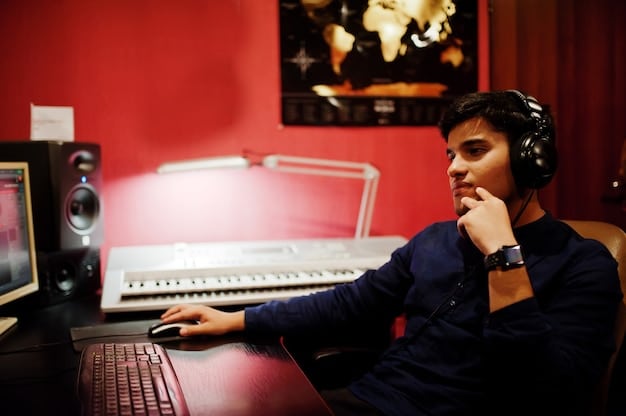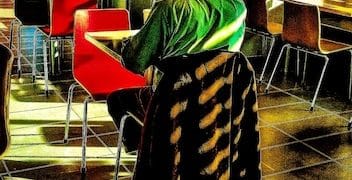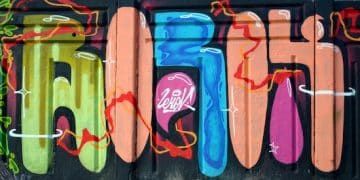Copyright Laws 2025: Impact on Hip Hop Sampling

The potential revisions to copyright laws in 2025 are poised to significantly alter the landscape of music sampling in hip hop, demanding greater transparency and stricter licensing for producers and artists.
How Will New Copyright Laws Impact Sampling in Hip Hop in 2025? This question resonates deeply within the music industry, especially as 2025 approaches with the promise of potential shifts in copyright legislation. For decades, sampling has been a cornerstone of hip hop’s sonic identity—a creative mosaic built from existing sounds. Yet, this artistic freedom often collides with complex legal frameworks, making the future of this fundamental practice a subject of intense speculation and concern among artists, producers, and legal experts alike.
The Evolving Landscape of Copyright in Music Production
The digital age has fundamentally transformed how music is created, distributed, and consumed. In this rapidly changing environment, copyright laws struggle to keep pace with technological advancements, especially concerning practices like sampling. For hip hop, a genre built on the innovative repurposing of sounds, these legal intricacies are particularly crucial. Understanding the current state and anticipated shifts in copyright law is essential for anyone involved in music production.
Historically, copyright aimed to protect original creative works, giving creators exclusive rights over their material. However, sampling blurs these lines, taking fragments of existing works and transforming them into something new. This tension has led to countless legal battles and licensing complexities, pushing the industry to seek clearer guidelines.
The Digital Dilemma and Legal Precedents
The proliferation of digital audio workstations (DAWs) has made sampling more accessible than ever, allowing artists to effortlessly integrate diverse sounds into their compositions. While this fosters immense creativity, it also amplifies the potential for copyright infringement. Each sample, regardless of its length, theoretically requires clearance from the original rights holders—a process that can be arduous, expensive, and often impractical for independent artists.
- Grand Upright Music, Ltd. v. Warner Bros. Records Inc. (1991): This landmark case involving Biz Markie’s “Alone Again” set a strict precedent, ruling that “thou shalt not steal” in the context of sampling. It underscored the necessity of obtaining proper licenses.
- Bridgeport Music, Inc. v. Dimension Films (2005): The “three-second rule” or “de minimis” defense, which suggested that very short samples might be legally permissible, was largely dismissed by this ruling. The court stated simply, “Get a license or do not sample.”
- Fair Use Doctrine: While a potential defense, fair use arguments in sampling cases are notoriously difficult to win. Courts often scrutinize the purpose, nature, amount, and market effect of the sampled work.
These legal precedents have created a climate of caution within the hip hop community. Artists and labels often err on the side of caution, either meticulously clearing samples or avoiding recognizable samples entirely. The increasing interconnectedness of the digital world means that uncleared samples are more easily identified and targeted by rights holders, propelling the need for updated legislation that addresses modern creative practices.
Anticipated Legislative Changes and Their Scope
As we approach 2025, discussions around copyright reform are gaining momentum, driven by technological evolution and the increasing complexity of intellectual property in music. While specific new copyright laws impacting sampling in hip hop in 2025 are not officially enacted yet, there are ongoing policy debates and potential amendments that could reshape the legal landscape. These include streamlining licensing processes, establishing clearer criteria for fair use, and introducing new frameworks for micro-licensing.
One primary area of focus is how to make the licensing process more efficient and transparent. The current system is often fragmented, making it difficult for artists to identify and negotiate with all necessary rights holders. This inefficiency discourages legitimate sampling, pushing some artists toward either costly litigation or creative self-censorship. The aim is to create a more accessible pathway for creators to legally use copyrighted material, fostering innovation while respecting intellectual property rights.
Potential for Streamlined Licensing Platforms
Industry stakeholders are exploring the development of centralized databases or platforms where artists can easily search for available samples, view licensing terms, and complete transactions. Such systems could significantly reduce the administrative burden and legal risks associated with sampling. Imagine a world where a producer could quickly ascertain the cost and conditions for using a specific drum break or vocal snippet, much like stock photo agencies operate. This type of infrastructure would be a game-changer for the independent music community, empowering smaller artists and labels who often lack the resources for complex legal navigation.
- Blockchain Technology: Distributed ledger technology could provide an immutable record of ownership and usage, making sample clearance more transparent and automated. Smart contracts could release royalties directly to rights holders upon usage.
- Standardized Royalty Splits: Efforts might be made to establish industry-wide standards for royalty splits on sampled works, reducing the need for individual, often protracted, negotiations.
- Micro-Licensing Models: New models may emerge specifically designed for very short or heavily processed samples, recognizing that the economic value of a tiny snippet might warrant a different licensing approach than a significant portion of a track.
Another critical aspect of potential legislative changes revolves around refining the fair use doctrine for musical works. While fair use exists to balance copyright protection with public interest in creative expression, its application to sampling remains contentious. New laws might provide clearer guidelines on what constitutes “transformative use” in the context of sampling, potentially offering more predictable outcomes for artists who significantly alter or repurpose original material.

Impact on Hip Hop Artists and Producers
The potential shifts in copyright laws could dramatically alter the creative process and business models for hip hop artists and producers. For a genre that has historically thrived on the art of sampling, these changes are not merely legal technicalities; they are a fundamental reshaping of its artistic foundation. From creative freedom to financial viability, every aspect of hip hop production stands to be affected.
One of the immediate impacts could be a greater emphasis on original composition. If sampling becomes more restrictively regulated or prohibitively expensive, artists might pivot towards creating more original beats and melodies from scratch. This shift could push hip hop into new sonic territories, fostering innovation in sound design and instrumentation. While this can lead to fresh sounds, it also puts a greater burden on producers to develop unique musical elements, potentially moving away from the rich tapestry of sounds that define sampled hip hop.
Creative Constraints vs. Innovation
For some artists, stricter copyright laws might feel like a creative constraint, limiting their ability to draw from a vast library of existing music. The essence of sampling lies in its ability to juxtapose disparate sounds, creating new narratives and textures. If fear of legal repercussions makes artists hesitant to experiment with certain samples, it could stymie a unique form of artistic expression. However, this challenge could also spark new forms of innovation.
- Increased Use of Sound Banks and Royalty-Free Samples: Artists might increasingly turn to professionally curated sound libraries and royalty-free samples as a safe alternative, ensuring legal compliance without sacrificing the ability to build on existing sonic elements.
- Collaborative Songwriting: More collaborative efforts between producers, vocalists, and instrumentalists might emerge to create entirely original compositions that replicate the feel of sampled tracks, but without the legal baggage.
- Emphasis on Live Instrumentation: A resurgence of live instrumentation in hip hop production could occur, as artists seek to bypass sampling complexities by recording their own unique sounds.
Financially, the impact could be substantial. Artists and labels may face higher licensing costs, directly affecting profit margins. Independent and emerging artists, who often operate on limited budgets, could find it particularly challenging to afford the necessary clearances, potentially forcing them out of the sampling game altogether. This could create a more stratified industry, where only well-funded artists or those with significant legal backing can afford to engage in extensive sampling.
The ripple effect could also extend to the music libraries and legacy artists whose works are frequently sampled. While stricter laws might promise greater revenue for rights holders, overly restrictive policies could decrease the overall demand for their works as a source for sampling. A balance must be struck where rights holders are fairly compensated, but the creative ecosystem of hip hop is not stifled by excessive financial barriers. The goal should be to foster a system where artists can create vibrant, sample-rich music legally and affordably, benefiting both original creators and new innovators.
Licensing and Clearance: A Shifting Paradigm
The mechanisms for licensing and clearing samples in hip hop are poised for a significant transformation. Traditionally, this process has been opaque, costly, and time-consuming, often involving complex negotiations with multiple rights holders (publishers for the composition and record labels for the master recording). With new copyright laws potentially on the horizon for 2025, the paradigm is likely to shift towards more standardized, efficient, and technologically driven solutions.
One of the most anticipated changes is the move towards a more centralized and transparent licensing system. The current fragmented approach requires artists to identify, locate, and negotiate with individual rights holders, which can be a daunting task, especially for obscure samples or those from international sources. A streamlined system, possibly leveraging digital platforms and smart contracts, could dramatically simplify this process. This would reduce the overhead costs and legal risks associated with sample-based music, making it more accessible for a wider range of artists.
Role of Technology in Simplifying Clearance
Technology is set to play a pivotal role in democratizing the sampling process. Blockchain, for instance, offers the potential for immutable records of ownership and transparent transaction histories, making it easier to track and distribute royalties to all relevant parties. AI-powered tools could also assist in identifying source material and even automating parts of the licensing agreement.
- Automated Royalty Distribution: Smart contracts could automatically distribute agreed-upon royalty percentages to rights holders as soon as a sampled track generates revenue, removing the need for manual reconciliation and disputes.
- Global Sample Database: A comprehensive, internationally recognized database of pre-cleared samples or music available for licensing could emerge, complete with transparent pricing models based on usage, popularity, and duration.
- Fractional Ownership Licensing: New models might allow for fractional licensing of samples, enabling artists to license small, specific components of a track without needing to acquire full rights to the entire composition or master recording.
These technological advancements could foster an environment where sampling becomes a recognized and integral part of the music economy, rather than a legally precarious gray area. For rights holders, this could mean new revenue streams from their existing catalogs, as their music becomes more readily available for legitimate sampling. For artists, it means greater legal certainty and potentially lower barriers to entry for sample-based production.
However, implementing such systems comes with its own set of challenges, including securing industry-wide consensus, establishing fair pricing structures, and addressing legacy issues of uncleared samples. The ultimate goal is to create a symbiotic relationship between original creators and those who creatively repurpose their work, ensuring fair compensation and fostering continued artistic innovation.
Emerging Trends in Hip Hop Production to Navigate New Laws
In response to the evolving copyright landscape, hip hop artists and producers are already embracing new creative and technological trends to navigate potential legal hurdles. These trends not only demonstrate the genre’s adaptability but also hint at the future direction of its sonic identity. The necessity to produce legally sound music is driving a wave of innovation, pushing artists to explore less litigious avenues for their creative expression.
One significant trend is the rise of original composition as a primary method for beat-making. While sampling will likely remain a core element, producers are increasingly developing their own unique melodies, drum patterns, and instrumental arrangements from scratch. This involves a deeper reliance on synthesizers, live instrumentation, and sophisticated digital sound design tools. The aim is to create tracks that evoke the “feel” of classic sampled beats but with entirely original components, thus bypassing copyright concerns.
Alternative Creative Strategies
As the legal framework tightens, producers are also becoming more adept at manipulating samples beyond recognition or focusing on royalty-free resources. This shift requires a different kind of creativity, where the focus moves from direct appropriation to transformative artistry.
- Extreme Sample Manipulation: Producers are using advanced processing techniques—such as extreme stretching, pitching, granular synthesis, and filtering—to transform source material into entirely new sounds that bear little resemblance to the original, making them potentially fall under fair use or simply harder to identify.
- Royalty-Free and Public Domain Assets: There’s a growing reliance on curated sound libraries, public domain archives, and actively licensed “loop packs” that offer pre-cleared sounds for commercial use. This allows artists to build intricate tracks legally and affordably.
- Modular Synthesis and Sound Design: A renewed interest in modular synthesizers and advanced sound design techniques is empowering producers to generate unique sounds and textures from the ground up, providing a distinct sonic fingerprint free from licensing issues.
Another emerging trend is the increasing collaboration between hip hop producers and live musicians. Artists are commissioning instrumentalists to re-record classic samples or create original melodic lines and drum breaks, effectively “faking” the sample without infringing on copyrights. This approach not only ensures legal compliance but also adds a rich, organic quality to the music that digital samples sometimes lack.
Furthermore, the independent music scene is fostering communities where artists share original sounds and collaborate on compositions designed specifically for sampling within a closed, consensual ecosystem. These “sample packs” or “loop collectives” operate on agreements that grant clear usage rights, demonstrating a proactive approach by artists to create legally viable pathways for sample-based music. These trends suggest a resilient and innovative spirit within hip hop, ready to adapt to new legal realities while continuing to push artistic boundaries.
Legal Challenges and Enforcement in 2025
The implementation and enforcement of new copyright laws in 2025, particularly those impacting sampling in hip hop, will undoubtedly present significant legal challenges. While the intent might be to clarify and streamline, the practical application of these laws in a rapidly evolving digital landscape is rarely straightforward. Anticipated challenges include navigating international legal differences, effectively policing digital content, and ensuring equitable enforcement across the industry.
One of the primary difficulties lies in the global nature of music distribution and consumption. Copyright laws vary significantly from country to country, creating a complex web of jurisdictions for music creators and rights holders. A sample legally cleared in one country might be subject to different regulations elsewhere. New international agreements or harmonized standards would be necessary to ensure consistent enforcement, but achieving such consensus is a monumental task.
Difficulty in Digital Policing and AI Detection
The sheer volume of music uploaded daily to streaming platforms and social media presents a massive challenge for copyright enforcement. While AI and audio fingerprinting technologies are becoming increasingly sophisticated at identifying sampled material, they are not infallible. They can struggle with heavily processed or very short samples, leading to either false positives or missed infringements. This grey area will likely be a source of ongoing legal disputes.
- Technological Arms Race: As detection methods improve, artists may develop more advanced manipulation techniques to obscure samples, creating a continuous “cat and mouse” game between creators and enforcement bodies.
- Platform Liability: Clarity will be needed regarding the responsibility of streaming platforms and social media sites in policing copyrighted content. Will they be held more accountable for user-uploaded music containing uncleared samples, and what will be the mechanisms for quick takedowns and dispute resolution?
- “De Minimis” Revisited: Despite past rulings, the concept of “de minimis” (too trivial to matter) might subtly re-emerge in practice as enforcement bodies grapple with the practicalities of prosecuting every minute sample, especially if new micro-licensing models arise.
Ensuring equitable enforcement is another critical challenge. Smaller artists and independent labels often lack the legal resources to defend themselves against infringement claims, even if they have a legitimate fair use argument. Conversely, large corporations might wield their legal power disproportionately. New laws would ideally include provisions to support more accessible dispute resolution mechanisms and perhaps even mediation services to level the playing field.
Ultimately, the effectiveness of new copyright laws in 2025 will depend on their ability to adapt to technological change, provide clear guidance to creators, and facilitate fair and efficient dispute resolution. The goal is not merely to punish infringement but to foster an environment where creative expression can flourish within a framework that respects intellectual property rights.
The Future of Creativity and Compensation in Hip Hop
The intersection of new copyright laws and the evolving music industry in 2025 poses profound questions about the future of creativity and compensation in hip hop. While challenges abound, there is also an immense opportunity to forge a more transparent, equitable, and sustainable ecosystem for artists and rights holders alike. The dialogue often centers on restrictions, but the potential for growth and innovation within a clearer legal framework should not be underestimated.
Creativity in hip hop has always been about transformation and pushing boundaries, whether through lyricism, beat-making, or cultural influence. If new laws provide clearer pathways for legitimate sampling, this could actually empower artists by removing the pervasive fear of legal repercussions. Imagine a world where producers can confidently experiment with diverse source material, knowing that the tools and frameworks for legal compliance are readily available and affordable. This certainty could foster an even greater explosion of creativity, as artists feel more liberated to explore novel sonic landscapes. The genre’s inherent innovative spirit will find new outlets, perhaps even leading to hybrid forms of music that redefine how samples are perceived and used.
Balancing Rights and Fostering Innovation
The core tension lies in balancing the rights of original creators with the desire to foster new artistic expressions. Future legal frameworks could achieve this by:
- Promoting Collaborative Models: Encouraging direct partnerships between artists and original rights holders, possibly through formal mentorships or artist residencies, to create new works from existing material with clear upfront agreements.
- Education and Awareness: Investing in robust educational programs for emerging artists about copyright law, fair use, and licensing best practices, ensuring that creative freedom is pursued with legal literacy.
- Incentivizing Innovation: Designing policies that not only protect existing works but also provide incentives for transformative use, recognizing the cultural and economic value added by new creations that build upon foundational art.
From a compensation perspective, the goal is to ensure that a larger share of the revenue generated from sample-based music flows back to all contributing parties—original creators, producers, and performing artists. New technologies, like blockchain, could introduce unprecedented transparency into royalty collection and distribution, ensuring that every play, stream, or sale triggers automated payments to all registered rights holders. This could particularly benefit legacy artists whose works are frequently sampled, providing them with ongoing revenue streams decades after their original release, as well as emerging artists who might negotiate more favorable terms within a transparent system.
The future of hip hop is not just about adapting to laws; it’s about shaping them. Artists, legal experts, and industry leaders must continue to advocate for policies that acknowledge the genre’s artistic methodology while upholding principles of fair compensation. By embracing technology and fostering a culture of legal literacy, hip hop can continue to thrive creatively and economically in a more legally defined landscape.
| Key Takeaway | Brief Description |
|---|---|
| ⚖️ Stricter Enforcement | Expect clearer rules and more efficient detection of uncleared samples, potentially increasing legal expenses for artists. |
| 💡 Creative Adaptation | Artists may shift towards original compositions, royalty-free samples, or advanced manipulation techniques. |
| 🔗 Licensing Innovations | New digital platforms or blockchain could streamline sample clearance and royalty distribution. |
| 💸 Economic Shifts | Higher costs for traditional sampling could lead to new revenue models and opportunities for original works. |
Frequently Asked Questions
▼
No, a complete ban on sampling in hip hop is highly unlikely. Instead, the focus will likely be on clarifying and streamlining the licensing process to ensure proper compensation for rights holders. The goal is to make legitimate sampling more accessible, not to eradicate it entirely, as it’s integral to the genre’s history.
▼
New simplified licensing platforms and micro-licensing models could emerge to make the process more affordable for independent artists. Additionally, there may be a shift towards using royalty-free sample packs or creating original compositions to avoid traditional clearance costs altogether, fostering new creative approaches.
▼
Yes, blockchain technology has significant potential to revolutionize sample licensing. Its ability to create immutable records of ownership and use, coupled with smart contracts for automated royalty distribution, could make the entire process more transparent, efficient, and equitable for all parties involved in a sample’s lifecycle.
▼
While fair use is a legal defense, its application to sampling remains challenging and complex. Though new laws might provide clearer guidelines on “transformative use,” it’s generally safer to obtain licenses for commercial releases. Artists may, however, explore more extreme sample manipulation to strengthen fair use arguments by making the original virtually unrecognizable.
▼
Artists are already shifting towards creating original compositions using synthesizers and live instrumentation. They might also increasingly use thoroughly processed royalty-free samples or engage in direct collaborations with instrumentalists to recreate sampled sounds, fostering innovation through synthesis, sound design, and collaborative original work.
Conclusion
The prospective evolution of copyright laws by 2025 casts a significant, yet not entirely foreboding, shadow over the future of sampling in hip hop. While the genre may face increased scrutiny and potentially higher licensing costs, these challenges could also catalyze remarkable innovation. Expected developments in streamlined licensing, bolstered by technological advancements like blockchain, promise to demystify and democratize the clearance process, potentially opening new pathways for creativity and fair compensation. Ultimately, the resilience and adaptability ingrained in hip hop’s DNA suggest that it will likely emerge from these legal recalibrations not diminished, but transformed, continuing its legacy of pushing artistic boundaries within a more structured, transparent environment.





